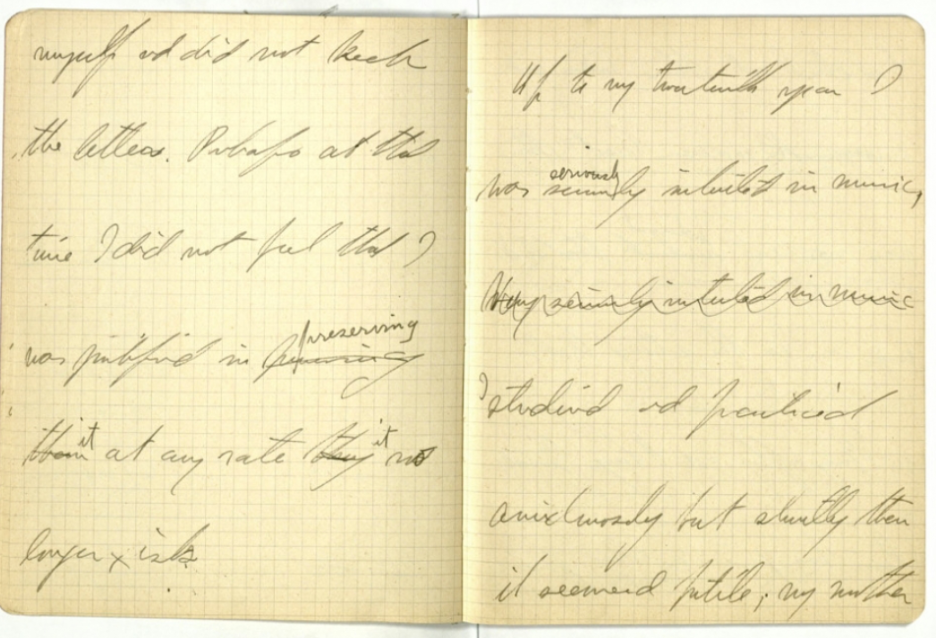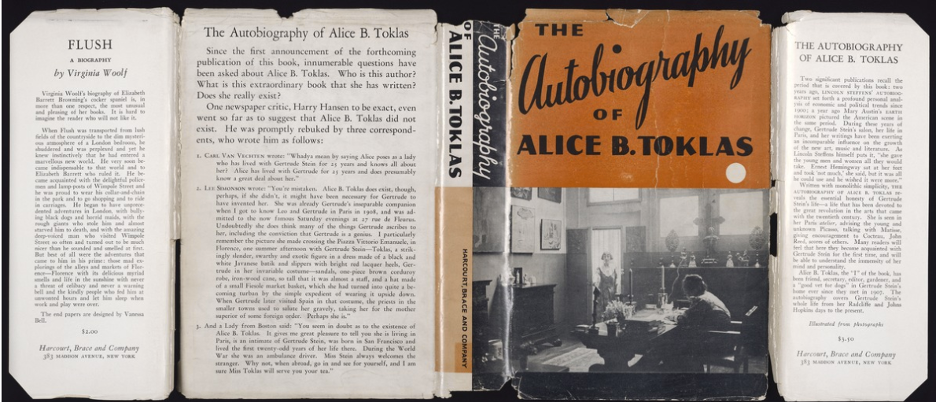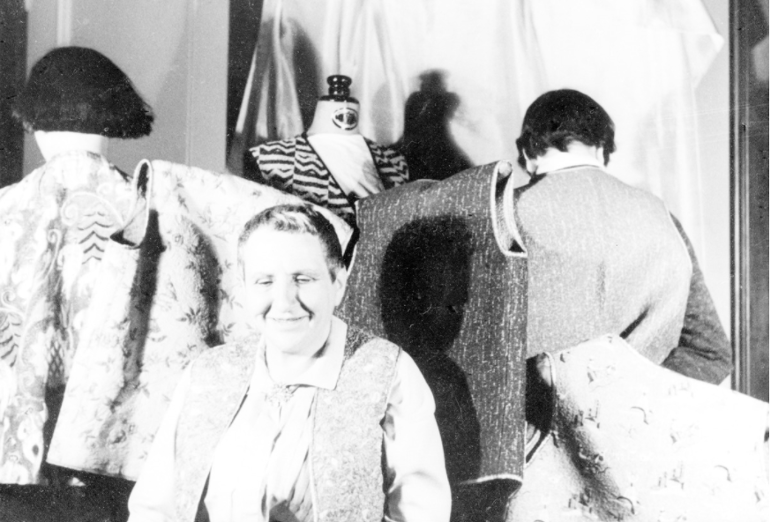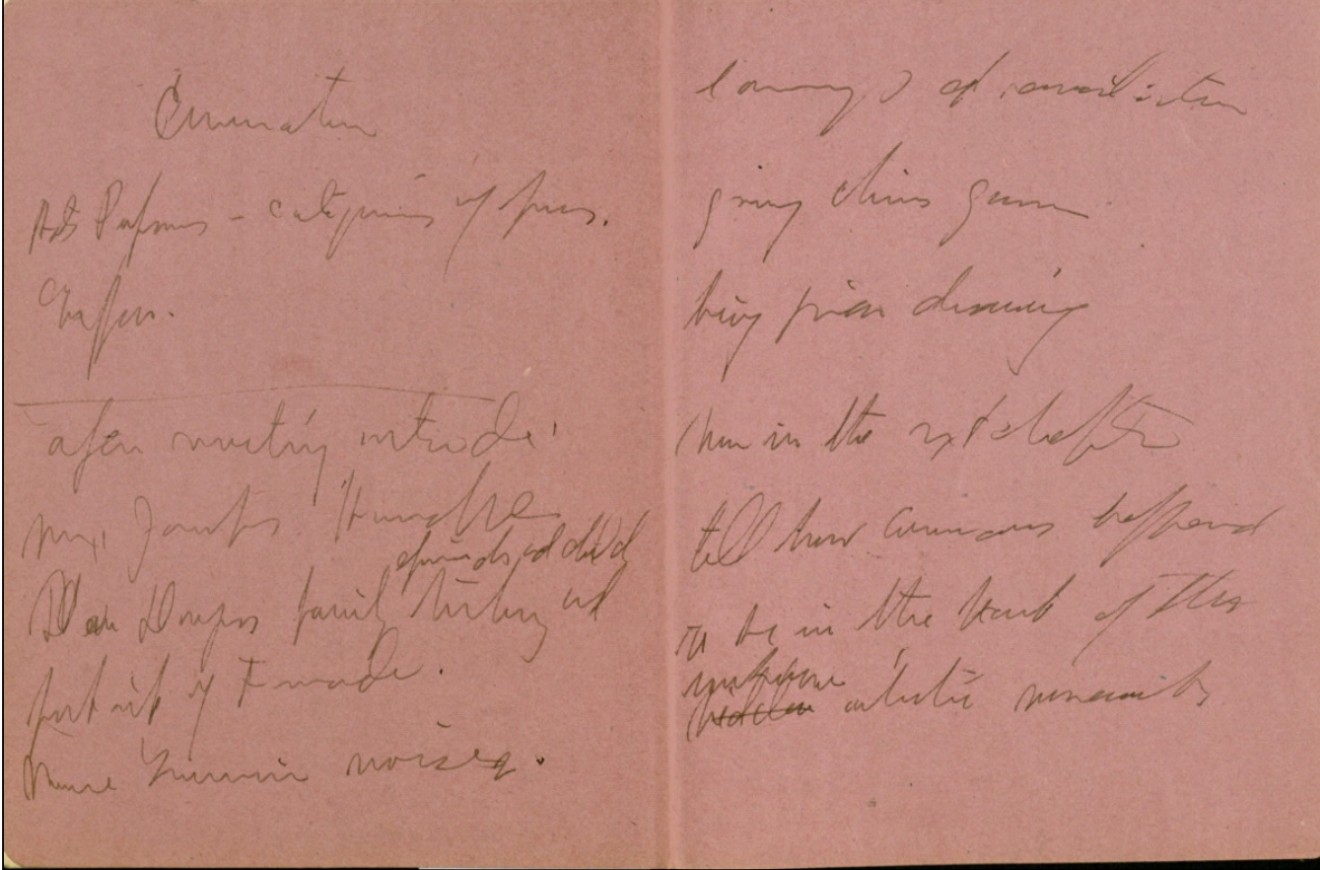Work In Progress: Case Study #3
Gertrude Stein, The Autobiography of Alice B. Toklas
READ the published text, available online via Project Gutenberg. Stein wrote The Autobiography of Alice B. Toklas in October and November of 1932. It was the first of Stein’s work to be published by Atlantic Monthly: in 1933, the magazine published the majority of the book, in four installments.
COMPARE several drafts of the text available in Beinecke’s Digital Library: Call Number: YCAL MSS 76.
As Janet Malcolm discusses in her essay “Gertrude Stein’s War,” this manuscript is exceptional because “Stein never, or hardly ever, revised: a rare false start to The Autobiography of Alice B. Toklas exists among Stein’s papers”.

Stein’s handwriting is difficult to parse, but the text of the draft in most places matches with the text of the published manuscript. Reading the two side-by-side will aid in deciphering her handwriting.

Stein’s edits are frequently small, word-level modifications. In some places (as pictured below), she makes larger changes to the body of the text, even cutting whole pages of writing.


SEE ALSO several copies of the text available in the Beinecke’s Digital Library:
- This first edition has the author’s presentation inscription to C. Van Vechten and Carl Van Vechten’s bookplate. First binding of silver blue cloth and white end sheets, partially digitized. (Call Number: Za St34 933A.)

- This dust cover, from the book’s second printing in October 1933. (Call Number: Za St34 933A.) The inside flap contains an advertisement for Flush, Virginia Woolf’s biography of Elizabeth Barrett Browning’s cocker spaniel. Stein and Woolf’s texts both challenge our traditional idea of (auto)biography.

READ Testimony against Gertrude Stein, a pamphlet published by the experimental literary journal Transition, containing short writings by Georges Braque, Eugene Jolas, Maria Jolas, Henri Matisse, Andre Salmon, and Tristan Tzara. The booklet begins:
“Miss Gertrude Stein’s memoirs, published last year under the title of Autobiography of Alice B. Toklas, having brought about a certain amount of controversial comment, Transition has opened its pages to several of those she mentions who, like ourselves, find that the book often lacks accuracy. This fact and the regrettable possibility that many less informed readers might accept Miss Stein’s testimony about her contemporaries, make it seem wiser to straighten out these points with which we are familiar before the book has had time to assume the character of historic authenticity…These documents invalidate the claim of the Toklas-Stein memorial that Miss Stein was in any way concerned with the shaping of the epoch she attempts to describe. There is a unanimity of opinion that she had no understanding of what was really happening around her, that the mutation of ideas beneath the surface of the more obvious contacts and clashes of personalities during that period escaped her entirely…The Autobiography of Alice B. Toklas, in its hollow, tinsel bohemianism and egocentric deformations, may very well become one day the symbol of the decadence that hovers over contemporary literature.”
The artists go on to criticize—and essentially fact-check—Stein’s manuscript, citing lines from the text and providing comment. Testimony raises a question central to Autobiography of Alice B. Toklas: what is the relationship between truth, memory, and fiction in this reinterpretation of autobiography?
READ Two Lives, Janet Malcolm’s biography of Gertrude Stein and Alice B Toklas.
Janet Malcolm’s archive is housed at Beinecke, and contains many materials related to Two Lives, including research material, correspondence, and other objects. Also read her essay, “Gertrude Stein’s War,” published by the New Yorker in 2003 (referenced previously), which discusses Autobiography in the context of The Alice B. Toklas Cook Book, Stein’s process of writing and revising, and Stein’s life in Vichy France. This dossier, edited by Charles Bernstein, explores Stein’s wartime record.
MORE FROM BEINECKE COLLECTIONS
The Gertrude Stein and Alice B. Toklas Papers are housed at Beinecke. The Papers consists of manuscripts, letters, photographs, printed materials, and art and objects by and about Stein and Toklas, spanning the years 1901-1987. Highlighted objects include:
- Two Bolero style waistcoats. One, in red flower-patterned brocade cloth with gold trim and two-button closures. The second, in painted and quilted fabric depicting frolicking woodsmen and peasant women. (Call Number: YCAL MSS 76). A photo of Stein in one of these vests, by Carl Van Vechten, is available in the Digital Library.

- Square metal-frame locket with photograph of Gertrude Stein (ca. 1890s) attached to scrap of flowered cloth. (Call Number: YCAL MSS 76.)
- Dried flowers pressed on a leaf of graph-lined paper, undated.

Selected materials from the papers can be Papers can be viewed in the Beinecke Digital Library.
MORE ON GERTRUDE STEIN AND ALICE B. TOKLAS
Gertrude Stein (February 3, 1874 – July 27, 1946) was an American novelist, poet, playwright, and art collector. Born in the Allegheny West neighborhood of Pittsburgh and raised in Oakland, California, Stein moved to Paris in 1903, and made France her home for the remainder of her life. She hosted a Paris salon, where the leading figures of modernism in literature and art, such as Pablo Picasso, Ernest Hemingway, F. Scott Fitzgerald, Sinclair Lewis, Ezra Pound, Sherwood Anderson and Henri Matisse, would meet.
In 1933, Stein published a quasi-memoir of her Paris years, ”The Autobiography of Alice B. Toklas”, written in the voice of Alice B. Toklas, her life partner. The book became a literary bestseller and vaulted Stein from the relative obscurity of the cult-literature scene into the limelight of mainstream attention. Two quotes from her works have become widely known: “Rose is a rose is a rose is a rose,” and “there is no there there”, with the latter often taken to be a reference to her childhood home of Oakland.
Her books include ”Q.E.D.” (1903), about a lesbian romantic affair involving several of Stein’s friends; ”Fernhurst”, a fictional story about a love triangle; ”Three Lives” (1905–06); and ”The Making of Americans” (1902–1911). In ”Tender Buttons” (1914), Stein commented on lesbian sexuality.
Her activities during World War II have been the subject of analysis and commentary. As a Jew living in Nazi-occupied France, Stein may have only been able to sustain her lifestyle as an art collector, and indeed to ensure her physical safety, through the protection of the powerful Vichy government official and Nazi collaborator Bernard Faÿ. After the war ended, Stein expressed admiration for another Nazi collaborator, Vichy leader Marshal Pétain.
(Source: Beinecke Digital Library)
Alice Babette Toklas (April 30, 1877 – March 7, 1967) was an American-born member of the Parisian avant-garde of the early 20th century, and the life partner of American writer Gertrude Stein.
(Source: Beinecke Digital Library)
SOURCES
Souhami, Diana- Gertrude and Alice: Gertrude Stein and Alice B. Toklas. Rivers Oram Press/Pandora List, 20 February 1992.
RESOURCES:
Work In Progress: Notes, Drafts, Revision, Publication
Work In Progress: Case Study #1 James Baldwin, An Open Letter to My Sister, Miss Angela Davis
- Gabrielle Colangelo, Y’21
Yale Collection of American Literature Student Research Assistant
